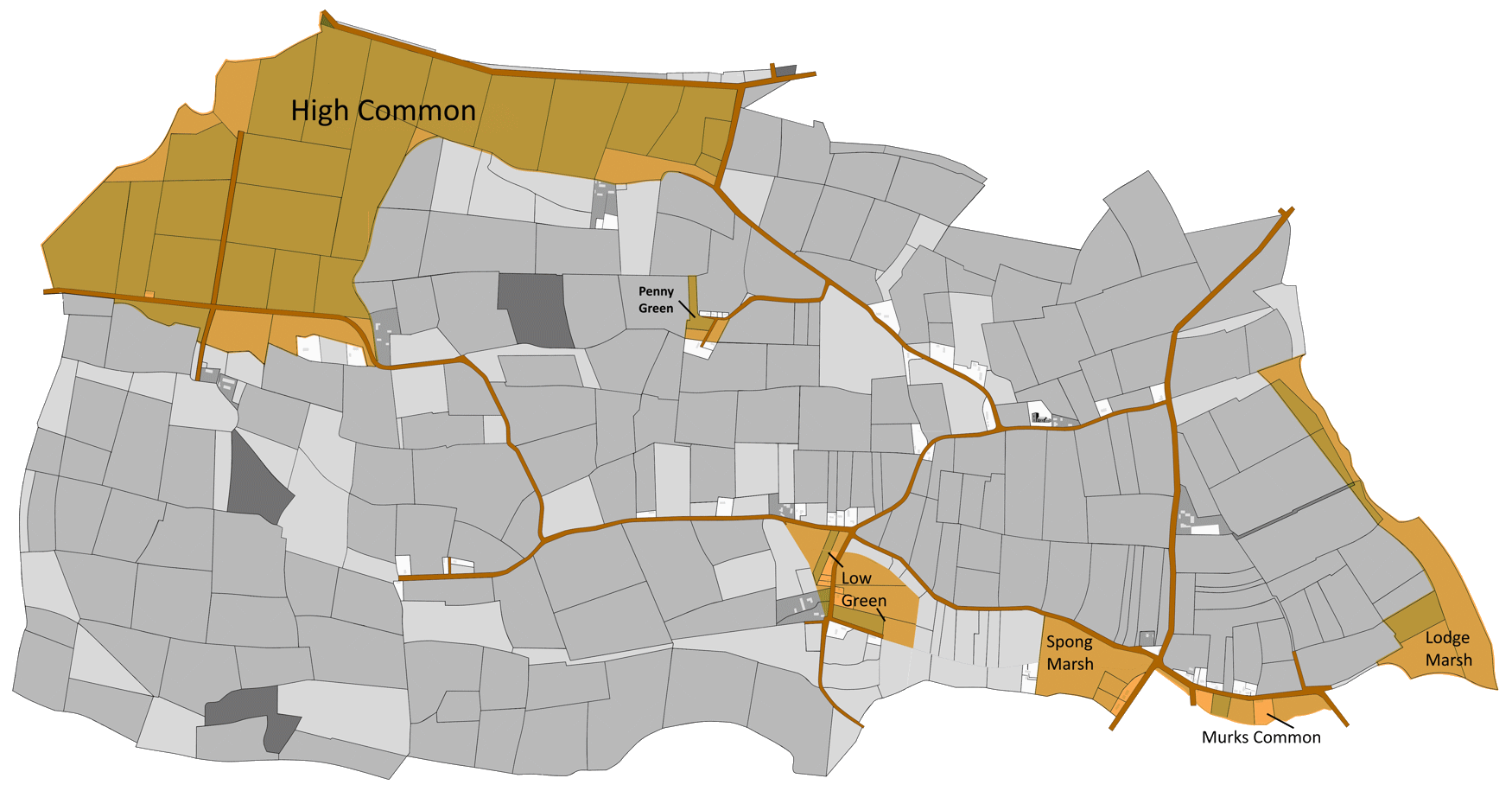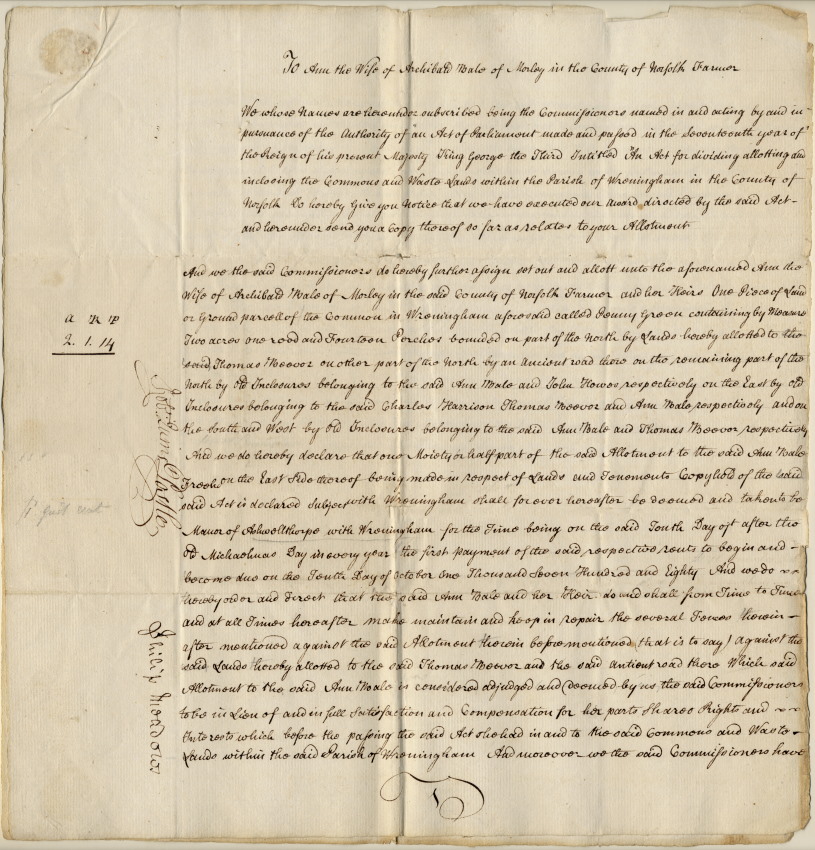
Across the nation there was once a lot of Common Land. However, Commons were considered unhelpful in maximising agricultural production. In the late 1700s, it was decided to sell off as much as possible. The process to achieve this were the parliamentary enclosures acts – “enclosure” generally being written: “inclosure”.
The legal process was spread over many years, and there were over 5,200 separate enclosures acts across the nation – taking a great deal of paliamentary time. The “Wreningham Inclosures Act” was in 1777.
A map showing the various Wreningham commons would have been produced as part of the Commissioners’ report at the time. Whilst allocation maps have survived from other Norfolk villages, sadly, none has been found for Wreningham. Perhaps Westminster has retained a copy with its original documentation? However, there are two original Wreningham tithe maps from 1838/9 which show certain groups of fields outlined with heavy lines – suggesting the old commons land boundaries. Using this information, a commons map (overlaid on our own reconstruction of the original tithe map for Wreningham) is provided at the top of the page.
The Wreningham “Inclosure” Act
“An Act for the dividing, allocating and enclosing the Commons and Waste Lands within the parish of Wreningham in the County of Norfolk“.
The Wreningham Allocations were determined by three commissioners: Robert Quince – from Honington in Suffolk, Jehosaphat Postle – from Norwich and Philip Meadows – from Diss. The Norwich Directory piblished in 1783 describes Jehosaphat Postle to have been an Attorny at No1 Castle Meadow.
In due course, the commissioners produced a report – the narrative of which comprised over three dozen pages. As described below, a dedicated “allocation” document for each property was also created. The largest allocations are listed in the following table:
| 10 largest Commons Land purchasers in the Wreningham enclosures “allocation” | …… and what they paid in pounds, shillings and pence |
| Charles Harrison – esquire | £221 13s 1d |
| Sir Thomas Beevor – esquire | £220 16s 19d |
| Mr Brand Fuller | £40 12s 0d |
| Mr Edward Parkes | £21 4s 8d |
| Mr Peter Turner | £20 4s 8d |
| Mrs Mary Day (wife of James) | £18 4s 3d |
| Mr John Long | £15 16s 7d |
| Harry William Wilson – esquire (The Manor?) | £11 9s 2d |
| Mrs Ann Bales (wife of Archibald) | £10 11s 9d |
| Mrs Ann Bensley (wife of John) | £8 15s 3d |
A transcription of the complete (and very long!) Wreningham “Inclosure” Act is provided in this link.
In total, 25 individuals paid a total of £656 14s for “Common” and “Waste” land in Wreningham – although, as can be seen above, the greater part of the total was divided between Charles Harrison and Thomas Beevor.
Charles Harrison lived at Palgrave, near Diss where he owned a large estate. Being from the Diss area he would probably have been an acquaintance of Philip Meadows, one of the Commissioners! At some point, Charles Harrison had come into possession of other land in Wreningham. By the time of the Great Farm Auction of 1869, after the death of his last surviving daughter, Mary, the Harrison land-holding in Wreningham included three farms – amounting to more than 600 acres.
Thomas Beevor bought only slightly less land than Charles Harrison. Beever – eventually a Baronet, he lived at Hethel Hall. He had also stood for a Norwich parliamentary seat (unsuccessfully!) on three separate occasions. In 1750, Thomas Beevor had married Elizabeth Branthwayt of Hethel Hall and, on the death of her father, he inherited a great deal of land in Hethel, East Carlton and Wreningham.
Mary Day wife of James Day, bought a large part of Lows Common – a wedge shaped piece of land straddling the north end of Ashwellthorpe Road and running along a boundary near the south side of Mill Lane. James Day had been a thatcher and was the first of the Day family to arrive in Wreningham. The Day family subsequently divided some of this land into orchards and also built a small number of houses.
Each “sold off” enclosure had its own legal documentation. Here is the first of a two page “Allotment” document for the purchase of the “Penny Green” Common by “Ann the wife of Archibald Bale”. This appears to have been the smallest complete “Common” in Wreningham. She paid £10 11s 9d which resulted in her owning 2 acres, 1 rood and 14 perches of land. Ann Bale lived in Morley – not far from Wymondham. Like today, it was not unusual for landlords to live elsewhere.
There are two of these original and complete Allotment / Award documents still in Wreningham that we know about. Do you know of any others?
We understand from the consolidated report prepared by the same commissioners that the entire “Common and Waste Ground” in Wreningham amounted to 260a 2r 1p.

